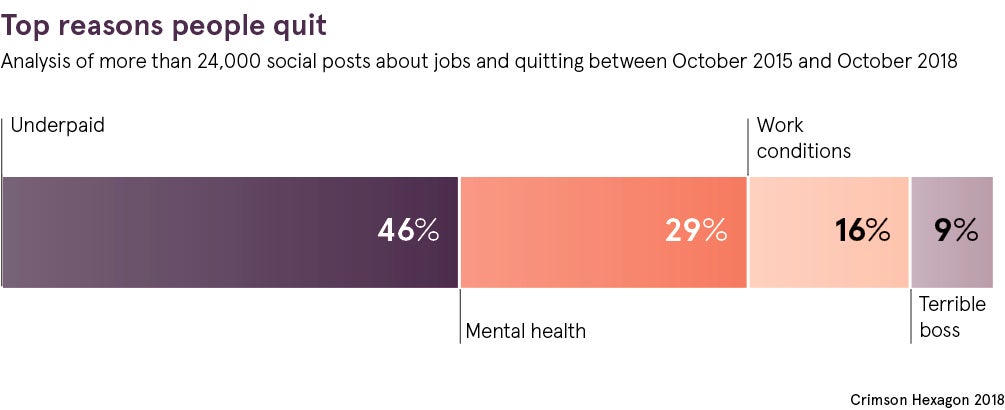At factories, military bases and state-owned enterprises across China, employees’ brains are monitored by artificial intelligence (AI), and the emotional data harvested is used to boost profits.
While corporations in the West do not use AI in this intrusive way, human resources leaders are waking up to the power of machine-learning to understand their employees better. Aside from the arguably nefarious possibilities of tighter employee control, positive applications include strengthening trust and even preventing quitters.
State Grid Zhejiang Electric Power’s profits reportedly leapt by $315 million after workers donned wearable sensors in 2014, a Big Brother scenario many HR directors in the West would reject.
But they are considering more palatable AI-powered algorithms to improve retention rates and the return on human capital, confirms Ken Lahti, chief science and innovation officer at SHL, psychometric tests vendor.
A workplace that deploys AI to monitor and mould behaviour may not necessarily herald an ethical future, but is inevitable
How tech and data are helping identify potential quitters
Traditionally, employee engagement is measured at HR touchpoints of recruitment, appraisal and exit; AI-enabled adaptive training, where questions are tailored in real time according to employee response, enables more accurate profiling, says Mr Lahti. “Similarly, training an algorithm to automate the interpretation of high volumes of text responses to open-ended questions accelerates feedback and makes evaluation more efficient,” he adds.
More radically, HR directors are experimenting with marketing concepts such as sentiment analysis, where tone of voice and facial expression are measured. Emotion and sentiment are fleeting, Mr Lahti cautions, and at present do not yield longer-term predictive information, which might be valuable in determining employee retention probability. Nonetheless, HR is interested and vendors are starting to push.
Other focused applications of data analytics and algorithms are already proving fruitful, as US chocolate maker Hershey testifies. “We needed to make talent planning a cyclical and predictable process to ensure continuity across our business,” says Sean Kirlin, Hershey’s senior manager of HR operations and systems. The company crunched foundational employee profile data to spot potential quitters.
Emilie Thomas, director of advanced analytics at Hershey, built the retention model and included data on employees’ managers, year-on-year performance and distance of commute as indicators. “The retention model takes all these factors, and more, to come up with remarkably accurate predictions; it’s correct about 87 per cent of the time, which enables HR practitioners and leaders to take action on these insights,” she says.
How gamification and consistent feedback could change quitters’ minds
HR is playing catch-up with such applications of big data and analytics to improve employee retention. Machine-learning that is embedded in employee interactions with work systems takes it a step further offering opportunities to monitor and shape behaviour.
Gamification, personalised to an employee’s working style, promises to be an HR tool that could deter quitting, says Dr Panos Constantinides, associate professor of digital innovation at Warwick Business School.
“Beyond game mechanics and incentives in the form of badges, leader boards and so on, an AI-enabled system that utilises natural-language processing, text analysis and biometrics could assess the deeper behaviours and motivations of employees,” he says. “Feedback could inform development, training and collaboration in the workplace, as well as ‘nudges’, small prompts that can have a big impact on people’s behaviours.”
An AI-directed nudge could potentially be deployed as a deterrent to quitters. Google’s former HR chief Laszlo Bock is leading the development of Humu’s Nudge Engine. The app uses behavioural science and machine-learning to deliver personalised nudges to workers throughout the day and answers the conundrum of AI identifying the quitter, but HR not knowing how to intervene.

Ethical concerns may not be the factor to hold employee monitoring back
Chatbots offer another means of monitoring employee sentiment, if not continuously then certainly at more frequent intervals than the bi-annual employee satisfaction survey. Payroll and benefits requests, business travel, IT callouts and sick leave could become touchpoints for canvassing employees’ feelings towards work and workplace, according to Cathal McGloin, chief executive of startup ServisBOT. “Capturing employee sentiment early and often is an effective way to avoid staff turnover. Bots can play a significant role,” he says.
A workplace that deploys AI to monitor and mould behaviour may not necessarily herald an ethical future, but is inevitable, says Michael Sippitt, chairman of Clarkslegal law practice. He is concerned that the law cannot keep pace with AI, and human rights and privacy legislation offer little protection when workers consent to scrutiny of data as part and parcel of their employment.
“The International Labour Organization has begun to look at the future of work in its initiative to address the wide range of work-related challenges ahead, including the use of artificial intelligence to monitor and control workers,” says Mr Sippitt. Paradoxically, the potential for machine-learning and AI in the workplace to spot quitters may be limited less by legal constraints than by HR’s ability to formulate constructive interventions.
As SHL’s Mr Lahti says, retention is a cumulative process: “Once alerted to an issue, it’s too late. People quit long before they leave.”
How tech and data are helping identify potential quitters
How gamification and consistent feedback could change quitters' minds

